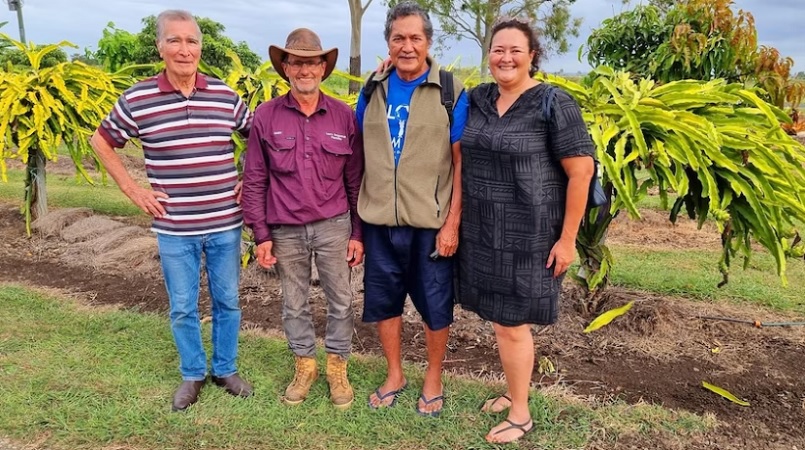
Expert help can be hard to come by for Samoan dragon fruit growers.
Organic coffee and koko samoa farmer Mele Mauala wanted to learn more about growing the fruit that is still new to her country, so she turned to an unlikely ally — Rockhampton dragon fruit farmer Gary Lee.
"Dragon fruit is a relatively new fruit to Samoa, but it's picking up speed and people are really enjoying it," Mauala said.
"It's one of the plants we'd like to see expand and grow in Samoa but, for that reason, we need to know a little bit more about it and the diversity of varieties that are available."
International interest
ABC Pacific reports Lee grows 90 different varieties on his farm at Alton Downs, about 20 kilometres north-west of Rockhampton in central Queensland.
As well as selling the fruit, Lee sells cuttings.
He said he often had inquiries from overseas.
But he was not expecting to give advice to someone establishing an industry in another country before he met Mauala.
"It's not something commonplace," he said.
"We do get a lot of people from around Australia and we get inquiries from other people who are wanting to farm them [dragon fruit]."
During her trip to his farm, Lee gave Mauala and her family advice on testing soil to make sure it met the requirements for growing dragon fruit, and showed her the different varieties he grew.
He said that sort of information could be hard to find when starting out.
"The hardest part about dragon fruit in Australia [is] there aren't a lot of people who know a great deal about them," Lee said.
"Unfortunately, even for us, it's a bit of trial and error and you make a few mistakes, and then you've got to rectify that because it is difficult to find people who can help you."
Certain dragon fruit varieties require pollination by hand, which Lee has to do at night using a special vacuum.
Mauala said her family only looked at varieties that could self-pollinate.
"That way we didn't have to worry about that," she said.
"The likelihood of many farmers being able to have access to a vacuum and being able to do that is not likely."
Taste test
Lee offered Mauala a tasting too.
"We've been picking fruit, so we've got a fair few different varieties in the fridge at the moment," he said.
"I cut up a few and they tried them and they were pleasantly surprised at how sweet some of the varieties are."
A few stood out to Mauala.
"There was one called American Beauty and we all said, 'Oh, this is a beauty'," she said.
"It was beautiful too — the colour was so rich and garnet, it was just lovely to look at but it was lovely to taste as well.
"We got to taste quite a few in a row, we could see the broad palette of flavour that dragon fruit can offer."
Establishing an industry
As well as being a farmer, Mauala is an executive board member with the Samoa Women's Association of Growers, which hosted a workshop on the tropical fruit earlier this year.
"We saw there was so much enthusiasm and interest," she said.
"I think because it's a low-maintenance fruit, you don't have to do too much in terms of setting it up.
"It's quite beautiful. I think we were all a little bit dazzled by it."
While more than 100 different varieties of dragon fruit exist, in Samoa there is only one white-flesh variety available, and fruit can cost $10 each.
Mauala wanted to see more women, young people, and villages grow the fruit so it could become more accessible for households to sell to the hospitality and tourism industries, and potentially create an export industry.
"We'd love to see how we can expand," she said.
"We can see the potential for those to actually foster the industry, then being able to have enough varieties so that we really can create the interest and not flood the market with just one variety."
Gary Lee (second from left) offered Mele Mauala and her family a tasting and talked through dragon fruit varieties.(Supplied: Mele Mauala)
